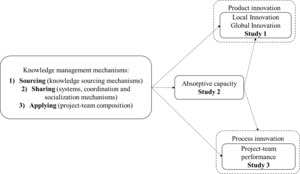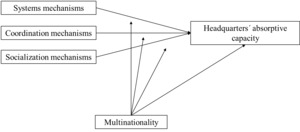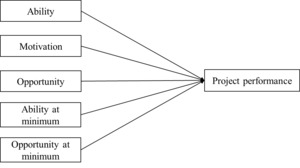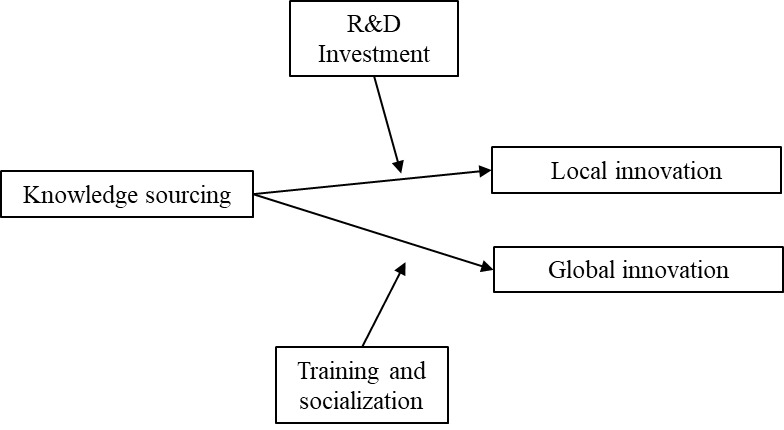Big Question
Can (and which) knowledge management mechanisms promote innovation and performance outcomes? What is the role of absorptive capacity?
Introduction and Overaching Model
Firms operating in emerging markets have increasingly conducted research and development (R&D) activities and have become a source of reverse innovation (Kumar, Mudambi, & Gray, 2013). However, emerging markets in general face less sophisticated institutional environments and scarcer resources, which impose additional constraints on developing technology advantages (Ramamurti, 2012). Therefore, those firms need to be particularly concerned with what types of managerial practices and incentives are more effective in generating innovations in order to develop their competitive advantages (Lynch & Jin, 2016).
Recognizing this managerial need, my dissertation aims to answer questions of “Can (and which) knowledge management mechanisms promote innovation and performance outcomes?” and “What is the role of absorptive capacity?” in the context of one of the largest emerging markets, Brazil. To do so, the dissertation contains three empirical studies, which consider distinct sorts of knowledge management mechanisms intended to support the knowledge processes (sourcing, sharing, applying), entailing different types of innovation (product and process innovation), which result in different outcomes (local innovation, global innovation, and performance). This overarching model is summarized in Figure 1.
Study 1: Fostering Local and Global Innovation
MNCs typically source knowledge in the countries where they operate and turn it either into innovation in the focal country (local innovation) or in foreign countries (global innovation).
But how can MNCs foster local and global innovation outcomes from the knowledge they sourced? There are basically two means: one focused on discovering new knowledge (e.g., R&D investments) and the other one focused on exchanging ideas from the existing knowledge stock (e.g., training and socialization) (Criscuolo, Haskel, & Slaughter, 2010). Both are expected to have an enhancing effect on absorptive capacity, which is a firm´s ability to recognize, assimilate and apply new knowledge to commercial ends (Cohen & Levinthal, 1990), by improving understanding and translation of sourced knowledge, respectively. However, given their different purposes, initiatives focused on discovering new knowledge and initiatives focused on exchanging existing knowledge may lead to different types of innovation, - local versus global innovation.
R&D investment which traditionally focuses on creating new knowledge, helps firms insert themselves more easily in local innovation networks (Scott-Kennel & Saittakari, 2020) and create product innovations that are country-specific (Cuervo-Cazurra, 2019).
On the other hand, training and socialization is focused on dissemination of existing knowledge among the various departments of the organization (Minbaeva, Mäkelä, & Rabbiosi, 2012) and as such it broadens the perspectives of employees to the worldwide operations of the firm. It favors the transfer of local knowledge to the global environment, helping firms to develop cultural intelligence (Ramsey & Lorenz, 2016) and overcome the liability of localness in innovation, that is, a competitive disadvantage local firms face in generating global product innovation (Un, 2016).
From a dataset of an annual survey administered eight years (2012-2019) with subsidiaries of foreign MNCs operating in Brazil and headquarters of local MNCs, the following model on the moderating roles of R&D investment and training/socialization was tested (Figure 2).
The findings show that there is no “one practice” that can enhance the effect of knowledge sourcing on both local innovation and global innovation. Therefore, firms aiming to foster local innovation should concentrate their efforts mainly in increasing R&D investments in order to achieve effective outcomes from their knowledge sourcing. On the other hand, firms aiming to foster global innovations should rather focus on providing training and socialization to their employees. Sourcing knowledge both internally and externally with a great variety of mechanisms also helps firms achieve better innovation outcomes, especially in the global environment.
Study 2: The Limited Complementarity between Drivers of MNC Headquarters’ Absorptive Capacity
In an international business context, headquarters have a central role in allocating resources and tools to foster the knowledge transfer process, especially considering that foreign subsidiaries are a significant source of knowledge capture.
MNC headquarters can therefore increase their ability to learn from their foreign subsidiaries. However, they should be aware of a potential trade-off between inward-looking and outward-looking determinants of AC. The inward-looking determinants of AC are mechanisms that promote internal communication efficiency, while the outward-looking determinants of AC are circumstances that provide access to knowledge from dispersed external sources. In their seminal paper, Cohen and Levinthal (1990) proposed a trade-off between these determinants of AC, which was empirically tested in Study 2.
In an international reverse knowledge transfer context, the inward-looking determinants of AC are knowledge management mechanisms within MNCs: systems, coordination, and socialization (Jansen, Van Den Bosch, & Volberda, 2005). The outward-looking determinant of AC is the magnitude and diversity of the MNC’s foreign operations, or its multinationality, that provides access to diverse knowledge bases from host countries. Using data from a cross-sectional survey conducted at 106 Brazilian and Portuguese MNCs, we tested the direct and indirect effects of these determinants of AC, as shown in Figure 3.
Findings point to a trade-off between the inward-looking determinant (i.e., coordination capabilities) and the outward-looking determinant (i.e., multinationality) in the context of international reverse knowledge transfers. When MNCs have their coordination mechanisms (e.g., R&D departments, training, and goals for innovation) too efficiently widespread throughout their global operations and, at the same time are highly internationalized, their absorptive capacity may be diminished. In this case, units communicate very effectively with one another but may become unable to recognize and value knowledge from diverse external sources, in an example of the Not-Invented Here (NIH) syndrome (Burcharth, Knudsen, & Søndergaard, 2014). Correspondingly, excessive levels of multinationality can lead to difficulties in accessing, interpreting and translating new external knowledge into a form that is understandable by the firm as such new knowledge may become too distant from the firms’ own knowledge base (Lane & Lubatkin, 1998). Expansion to geographies with different cultures adds complexity, making tacit knowledge exchange through formal coordination mechanisms less effective. For instance, if all subsidiaries of a highly internationalized MNC have their own R&D departments, training and goals for innovation, organizational complexity may increase to a point at which learning is hampered by information overload (Barkema & Vermeulen, 1998).
On the other hand, socialization mechanisms such as meetings, communities of practice, international trips, and international project teams are less susceptible to such trade-offs. Thus, the headquarters of highly internationalized MNCs should foster interpersonal relationships when absorbing knowledge generated by subsidiaries is a key objective. Personal interactions help reduce the cultural and linguistic barriers that stem from high levels of international exposure while promoting openness to new external knowledge. In other words, socialization mechanisms may help headquarters managers create awareness of new knowledge that is distant from their existing knowledge base, thereby avoiding the NIH syndrome. Over time, they should also help managers mobilize internal resources to assimilate strategically-relevant knowledge that would otherwise not emerge from structured coordination mechanisms.
Study 3: Knowledge Sharing within Teams of Simple and Complex Projects
Firms use team-based projects to manage activities and resources in an integrated way, and to share knowledge and best practices internally. However, the temporary and discontinuous character of projects can impose barriers to learning if abilities, motivations, and opportunities are not properly managed.
Taking a closer look at how teams work together to develop projects in MNCs, Study 3 explores knowledge sharing in projects at different levels of complexity (simple x complex projects). Bringing together the Project Management and Human Resource Management literatures, we suggest that teams achieve superior performance when they have an optimal combination of ability, motivation and opportunity (AMO) (Blumberg & Pringle, 1982; Boxall, 2003).
This study originates from a case-study at InterCement, an MNC producer of cement, lime, and special mortars headquartered in Brazil. InterCement has 40 business units spread across eight countries and exports to 17 countries. Objective data on project-team characteristics as well as financial performance was provided by the firm, totalling 285 continuous improvement projects.
We show that the interplay among project-teams´ ability, motivation and opportunity depends on the contextual factors that affect their absorptive capacity (simple x complex projects). When teams work in simple projects, ability is the key factor both as a main effect and, if it is too low, as a bottleneck for project performance (Figure 4). Firms undertaking simple, routine projects should prioritize achieving the minimum level of knowledge and skills needed within the team, so that members can apply their cognitive capabilities and efficiently make decisions.
On the other hand, when teams work in complex projects, ability, motivation, and opportunity reinforce each other to determine project performance (Figure 5). In such situations, motivation is the key factor as teams need more intense efforts (e.g., higher interaction among members) to develop absorptive capacity for effective problem-solving (Cohen & Levinthal, 1990).
In summary, in simple projects, the greatest improvement in project performance can be obtained by enhancing the team’s ability, which can be achieved by selecting team members with the required knowledge and skills, or through training, communication, and incentives. In complex projects, the greatest improvements in project performance can be achieved by increasing motivation reflected in higher interaction among team members. In addition to its own positive effect, this will amplify the effects of ability and opportunity.
Conclusions
This dissertation provides further evidence that MNC managers can use different mechanisms for sourcing, transferring, and applying knowledge, which can increase firm absorptive capacity and lead to different outcomes. For instance, exploitative innovation (e.g., process innovation) leads to performance outcomes while exploratory innovation (e.g., R&D and socialization) leads to innovation outcomes.
By distinguishing between local and global innovation we show that the requisites to innovate locally are different from the requisites to innovate globally. We also deepen our understanding of absorptive capacity, and showed a circumstance where R&D investment is more effective in generating AC, which is in environments where learning is easier (i.e., the local environment). We also reinforced the importance of training for absorptive capacity, especially in environments where learning is more difficult (i.e., the global environment).
However, managers should take into account the potential trade-off between inward and outward-looking determinants for AC, which particularly manifests in the context of international reverse knowledge transfers, when both coordination mechanisms and multinationality are high. In such situations, relying on socialization mechanisms seems to be more effective to promote the transfer of knowledge from subsidiaries to headquarters MNCs. Managers should also be aware of the need for more intense efforts and diversified knowledge to develop absorptive capacity for problem solving as complexity increases.
Overall, this dissertation provides novel insights on what amount of knowledge overlap is needed to increase absorptive capacity, on the trade-off between inward-looking and outward-looking AC, and on the contextual variables affecting knowledge management mechanisms and the development of AC.
Acknowledgements
I would like to thank my supervisor Torben Pedersen and co-supervisor Bent Petersen for their guidance. Thanks to Michael Mol, Randi Lunnan, Tina Ambos, Marcus Larsen, and Johannes Luger, for their thoughtful feedback on my dissertation. I´m also grateful to the opportunity to present my dissertation as finalist for the Buckley & Casson AIB Dissertation Award – AIB 2022.
About the Author
Livia Lopes Barakat (liviabarakat@fdc.org.br) is Associate Professor at Fundação Dom Cabral (FDC), Brazil. She is permanent faculty of FDC´s Professional Masters, academic director of FDC´s Executive MBA and coordinates the project Trajectories of Brazilian Multinationals. Her PhD was granted by Copenhagen Business School in 2021. She holds a Master of Science and a Bachelor degree in Administration from the Federal University of Minas Gerais. Her research interests are international strategy, knowledge management and cross-cultural management.










